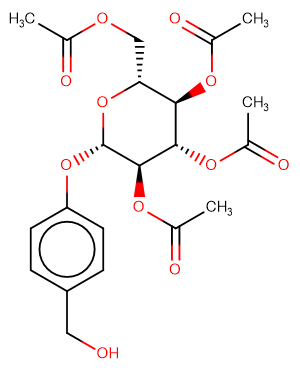
Acegastrodine
CAS No. 64291-41-4
Acegastrodine( —— )
Catalog No. M21525 CAS No. 64291-41-4
Acetagastrodin has an antispasmodic effect on vascular smooth muscle.
Purity : >98% (HPLC)
 COA
COA
 Datasheet
Datasheet
 HNMR
HNMR
 HPLC
HPLC
 MSDS
MSDS
 Handing Instructions
Handing Instructions
| Size | Price / USD | Stock | Quantity |
| 10MG | 29 | In Stock |


|
| 100MG | Get Quote | In Stock |


|
| 200MG | Get Quote | In Stock |


|
| 500MG | Get Quote | In Stock |


|
| 1G | Get Quote | In Stock |


|
Biological Information
-
Product NameAcegastrodine
-
NoteResearch use only, not for human use.
-
Brief DescriptionAcetagastrodin has an antispasmodic effect on vascular smooth muscle.
-
DescriptionAcetagastrodin has an antispasmodic effect on vascular smooth muscle.
-
In Vitro——
-
In Vivo——
-
Synonyms——
-
PathwayOthers
-
TargetOther Targets
-
RecptorOthers
-
Research Area——
-
Indication——
Chemical Information
-
CAS Number64291-41-4
-
Formula Weight454.4
-
Molecular FormulaC21H26O11
-
Purity>98% (HPLC)
-
Solubility——
-
SMILESCC(OC[C@H]([C@H]([C@@H]([C@H]1OC(C)=O)OC(C)=O)OC(C)=O)O[C@H]1Oc1ccc(CO)cc1)=O
-
Chemical Name(2R3R4S5R6S)-2-(acetoxymethyl)-6-(4-(hydroxymethyl)phenoxy)tetrahydro-2H-pyran-345-triyl triacetate
Shipping & Storage Information
-
Storage(-20℃)
-
ShippingWith Ice Pack
-
Stability≥ 2 years
Reference
1.Xiaochun Yang et al. Acetagastrodin Effects on Retinal Oscillatory Potentials in Patients During the Early Stages of Diabetes. Acta Diabetol. 2017 Jan;54(1):73-79.
molnova catalog



related products
-
Licoisoflavone B
Licoisoflavone B is an inhibitor of germ tube growth in the arbuscular mycorrhizal (AM) fungus Gigaspora margarita, it can strongly inhibit germ tube growth at 0.63 ug/disc.
-
8-CHLOROQUINAZOLIN-4...
8-CHLOROQUINAZOLIN-4(1H)-ONE is inhibitor of Poly [ADP-ribose] polymerase 1 (human).
-
Bisabolol oxide A
Bisabololoxide A induces apoptosis in rat thymocytes.



 Cart
Cart
 sales@molnova.com
sales@molnova.com


